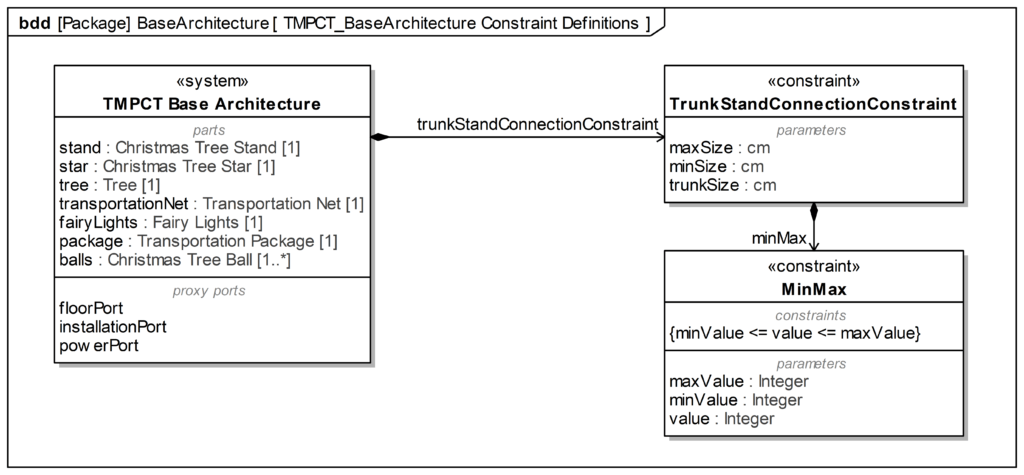Broadcast date: December 17th, 2021
You can join and
Welcome to the 17th door of our MBSE Podcast Advent Calendar. Today, we take a look at the modeling of parametric.
The parametric diagram depicts a network of constraints that constrain properties of the system. If your modeling tool is able to execute the constraints, it could be an extremely effective modeling approach.
So, let’s have a look at it in our model.

First, we need the expressions which are defined by constraint blocks. The lower constraint block specifies a min-max-expression using three parameters “minValue”, “maxValue”, and “value” which are each typed by our value-type “cm”.
The constraint block “TrunkStandConnectionConstraint” verifies that the trunk fits into the stand. It does not define a constraint but owns a constraint property typed by our “MinMax” constraint block.
The parametric diagram is a special kind of internal block diagram which depicts how the parameters of the constraints are connected with other parameters or value properties.

The parametric diagram shows the internal structure of the “TrunkStandConnectionConstraint” which simply connects its parameters with the appropriate internal constraint parameters of the “MinMax” constraint block.
We defined a constraint property of type “TrunkStandConnectionConstraint” owned by our system to use this constraint for the MBSE Podcast Christmas Tree.

In a parametric diagram of the “TMPCT Base Architecture”, we connected the parameters of the constraint with the appropriate value properties of the system. The value properties already have defined default values. However, they could be redefined later by the specialized properties in the physical architecture.

We also added another interesting constraint property. The constraint block “Height of the Tree” is a constraint block and a requirement at the same time. Since SysML v1.5, any named model element can also be a requirement.
The requirement and constraint block “Height of the Tree” requires and verifies that the height of the tree is between 150 and 200 cm.


The parametric diagram of the system element “The MBSE Podcast Christmas Tree” shows how everything is connected.
Our modeling tool can also run the constraints.

When we instantiate our TMPCT system element, we see in the output that the constraints are satisfied. This tool then displays the corresponding area in green.
So much for the 17th door of our MBSE Podcast Advent Calendar. We wish you a great 17th of December.
Podcast: Play in new window | Download
